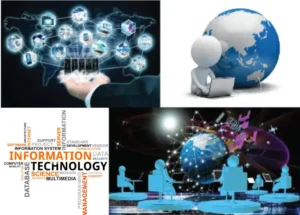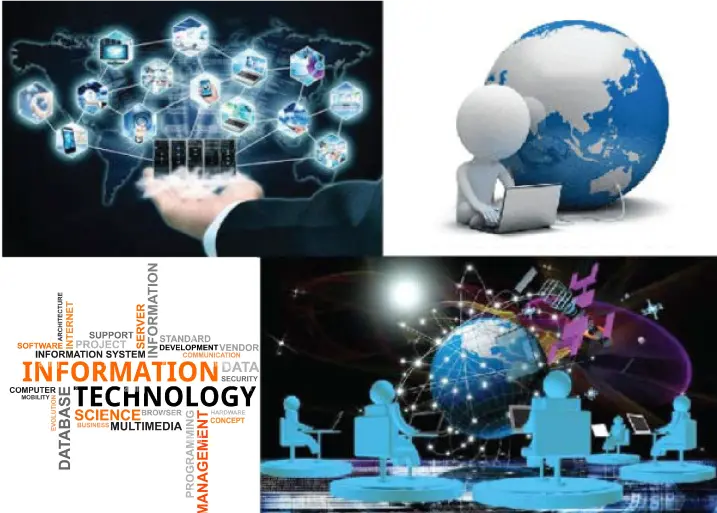Overview of the current state of Information Technology
The current state of Information Technology (IT) reflects a dynamic and transformative landscape where technological advancements continue to reshape how we live, work, and communicate. From the proliferation of cloud computing to TNowadays, Technology has become an integral part of our everyday routine. This is all thanks to the combination of smart devices and the Internet, which helps us stay connected and make our lives easier. These innovations work together to make our devices more intelligent and connected, making tasks more manageable and our lives more convenient.
In the business world, organizations leverage IT solutions for enhanced productivity, streamlined operations, and improved decision-making. The shift towards remote work has accelerated the adoption of digital collaboration tools, emphasizing the crucial role of IT infrastructure in supporting flexible work environments.
Cybersecurity, with increasingly sophisticated cyber threats, remains a paramount concern in the current IT landscape. As our world becomes more digital, protecting sensitive information and valuable digital assets is increasingly important. However, this can be difficult as Technology advances and new challenges arise.
Moreover, combining data analytics and machine learning has empowered businesses to extract valuable insights from vast datasets, driving informed decision-making and predictive analytics. The continuous evolution of mobile Technology has further expanded the reach of IT, enabling seamless Connectivity and access to information on the go.
In summary, the current state of Information Technology is marked by rapid innovation, pervasive integration into various sectors, and a continuous quest for efficiency and security in the digital realm. As we navigate this ever-evolving landscape, IT shapes the present and paves the way for an even more technologically advanced future.
1 . Importance of Information Technology in shaping the future
The importance of Information Technology (IT) in shaping the future cannot be overstated, as it catalyzes transformative changes across various aspects of our lives. Here are key reasons why IT plays a pivotal role in shaping the future:
Innovation and Progress:
- It is at the forefront of innovation, driving technological advancements and creating new possibilities.
- New and advanced technologies like artificial intelligence, blockchain, and quantum computing are transforming various industries and bringing many exciting opportunities.
Global Connectivity:
Information Technology has facilitated global Connectivity, breaking down geographical barriers.
- Communication tools, social media, and digital collaboration platforms enable instantaneous information exchange and collaboration across the globe.
Economic Growth and Competitiveness:
- Nations and businesses that invest in IT infrastructure and capabilities gain a competitive edge.
- It enhances productivity, efficiency, and the ability to adapt to rapidly changing market dynamics, contributing to economic growth.
Education and Knowledge Sharing:
- It has revolutionized education, making knowledge accessible to a global audience through online platforms and e-learning.
- Information dissemination and collaborative learning have been democratized, promoting continuous education and skill development.
Healthcare Advancements:
- It revolutionizes healthcare with electronic health records, telemedicine, and data-driven diagnostics.
- Predictive analytics and personalized medicine are made possible through IT, improving patient outcomes and healthcare delivery.
Environmental Sustainability:
- It contributes to environmental sustainability by enabling intelligent solutions for energy management, waste reduction, and resource optimization.
- IoT and data analytics are crucial in creating more sustainable and eco-friendly practices.
Social Transformation:
- It profoundly impacts societal dynamics, fostering Connectivity and social change.
- Social media and online platforms amplify voices, facilitate activism, and contribute to the dissemination of diverse perspectives.
Efficient Business Operations:
- It streamlines business processes, from supply chain management to customer relationship management.
- Automation, data analytics, and cloud computing enhance efficiency, reduce costs, and drive innovation in business operations.

Cybersecurity and Digital Resilience:
- In our current world, we depend significantly on Technology to accomplish our everyday tasks. As we rely more on Technology in our daily lives, we become more susceptible to online dangers like hacking, scams, and identity theft. That’s why protecting ourselves and our sensitive information from these threats is crucial.
- As we rely increasingly on Technology to help us in our lives, ensuring our digital information is safe from bad actors who might try to steal it becomes increasingly essential. This means protecting ourselves online, just like locking our doors to protect our physical belongings. By doing so, we can continue to use Technology to its fullest potential without worrying about our personal information being compromised. This helps ensure our digital systems and devices can withstand threats and function adequately.
Future Workforce Skills:
- IT skills are increasingly vital for the future workforce as Technology continues to shape the nature of jobs across industries.
- Continuous learning and adaptation to emerging technologies become imperative for individuals to remain competitive in the job market.
In essence, Information Technology shapes the future and is a cornerstone for societal, economic, and technological progress. Its impact is far-reaching, influencing how we live, work, connect, and solve global challenges. As we navigate the future, the role of IT will continue to be central in shaping a more interconnected, innovative, and sustainable world.
Evolution of Information Technology: A Historical Perspective
*1. The Birth of Computing (Early to Mid-20th Century):
- The origins of Information Technology can be linked to the early and mid-1900s when new machines like mechanical calculators and punch-card systems were first introduced. These new inventions helped people to perform complex mathematical calculations and store information in a more organized way. Over time, these technologies continued to evolve and paved the way for the modern-day computers and digital devices we use today.
- Pioneers like Alan Turing and John von Neumann laid the theoretical foundations for computing.
*2. The Emergence of Electronic Computers (1940s-1950s):
- The development of electronic computers marked a significant leap forward.
- ENIAC, the first general-purpose electronic computer, was completed in 1945, ushering in a new era of electronic data processing.
*3. Mainframes and Minicomputers (1950s-1960s):
- Mainframes and minicomputers became prevalent in the business and scientific communities.
- IBM’s System/360, introduced in the 1960s, was a pioneering mainframe system that set standards for compatibility.
*4. Microprocessors and Personal Computers (1970s-1980s):
- The invention of the microprocessor in the early 1970s revolutionized computing by enabling the creation of affordable personal computers.
- When Apple and IBM released their first personal computers, it meant that for the first time, people who didn’t work in big companies or have a lot of money could also have a computer in their homes or small businesses. This made it easier for more people to access and use computers.
*5. The Rise of the Internet (1980s-1990s):
- The development of the Internet transformed the landscape of information exchange.
- In 1989, a man named Tim Berners-Lee created the World Wide Web. This enabled more people to access and use the Internet for all sorts of things.
*6. Networking and Connectivity (1990s):
- The 1990s saw a rapid expansion of networking technologies.
- The proliferation of the Internet and the development of protocols like TCP/IP laid the groundwork for the interconnected world we know today.
*7. Mobile Revolution and Smart Devices (2000s-2010s):
- In the 21st century, we have witnessed the rise of mobile Technology and smart devices.
- The launch of smartphones and tablets and advancements in mobile networks reshaped how people access and interact with information.
*8. Cloud Computing and Virtualization (2010s-Present):
- Cloud computing emerged as a dominant paradigm, allowing users to access computing resources on demand.
- Virtualization technologies further optimize resource utilization and scalability.
*9. Artificial Intelligence and Machine Learning (2010s-Present):
- We live in a time when there have been significant developments in artificial intelligence (AI) and machine learning (ML).
- Advanced computer technologies like deep learning algorithms and neural networks have enabled significant advancements. Technology is helping us improve in many areas, like identifying objects in pictures, understanding and translating languages, and more. Autonomous systems. These breakthroughs could revolutionize how we interact with Technology and enhance our lives in numerous ways.
*10. Blockchain and Decentralized Technologies (2010s-Present):
– Blockchain technology gained prominence, introducing decentralized and secure data storage and transaction verification methods.
– Cryptocurrencies like Bitcoin and Ethereum emerged, challenging traditional financial paradigms.
*11. Edge Computing and IoT (Present-Future):
Information Technology (IT) has come a long way from its early days of basic computing concepts. Today, IT encompasses complex, interconnected, and intelligent systems. Cloud computing enables data storage and processing on remote servers, while edge computing processes data closer to the source, resulting in more efficient operations. The Internet of Things (IoT) is a system in which devices communicate through the Internet, facilitating real-time information exchange and more informed data-based decisions.
III. Key Components of Information Technology
*3.1 Hardware and Infrastructure:
- Historical Foundations:
- Early computing hardware comprised mechanical calculators and punch-card systems.
- The advent of electronic computers, starting with ENIAC in 1945, marked a shift towards electronic hardware.
- Evolution:
- Mainframes, minicomputers, and microprocessors revolutionized computing hardware.
- Advancements in semiconductor technology led to faster and more compact components.
- Contemporary State:
- High-performance servers, data storage arrays, and powerful processors form the backbone of modern IT infrastructure.
- Cloud computing platforms provide scalable and virtualized hardware resources.
*3.2 Software and Applications:
- Historical Foundations:
- Early software was closely tied to specific hardware, with programming done in machine language.
- Developing high-level programming languages, like Fortran and COBOL, facilitated software creation.
- Evolution:
- The rise of personal computers led to the development of operating systems like MS-DOS and graphical user interfaces.
- Software applications diversified, ranging from productivity suites to multimedia and gaming.
- Contemporary State:
- Operating systems like Windows, macOS, and Linux dominate personal computing.
- Mobile operating systems (iOS, Android) power smartphones, while web-based applications proliferate.
*3.3 Networking and Connectivity:
- Historical Foundations:
- Early networking involved point-to-point connections, such as telegraph and telephone systems.
- The development of ARPANET in the late 1960s laid the foundation for the Internet.
- Evolution:
- The Internet expanded globally with the development of protocols like TCP/IP.
- Wireless technologies (Wi-Fi, Bluetooth) revolutionized local Connectivity.
- Contemporary State:
- High-speed broadband and 5G networks enable fast and reliable internet connectivity.
- Networking technologies support cloud computing, facilitating the seamless flow of data globally.
Understanding the critical components of Information Technology is integral to grasping the intricate interplay between hardware, software, and networking. In the ever-evolving IT landscape, these components synergize to create robust and interconnected systems that drive technological advancements and shape the digital experiences of individuals and businesses alike.
IV. Impact on Various Industries
*4.1 Healthcare:
- Digital Health Records:
- It has revolutionized healthcare by implementing electronic health records (EHRs).
- Centralized and secure storage of patient information enhances care coordination and improves patient outcomes.
- Telemedicine:
- The integration of IT facilitates telemedicine, allowing remote patient consultations and virtual health services.
- Real-time data exchange enhances diagnostic accuracy and treatment planning.
*4.2 Education:
- E-Learning Platforms:
- IT has transformed education with the rise of e-learning platforms and online courses.
- Accessible and interactive digital content caters to diverse learning styles, fostering global education accessibility.
- Virtual Classrooms:
- Virtual classrooms, powered by IT, enable real-time collaboration and engagement among students and educators.
- Cloud-based collaboration tools enhance communication and streamline educational workflows.
*4.3 Finance:
- Online Banking and Transactions:
- IT has modernized the finance industry through online banking and secure electronic transactions.
- Blockchain technology is disrupting traditional financial systems, providing decentralized and safe alternatives.
- Algorithmic Trading:
- Advanced algorithms powered by IT drive automated trading systems, optimizing investment strategies.
- Big data analytics enhances risk assessment and decision-making in financial institutions.
*4.4 Manufacturing:
- Automation and Robotics:
- IT is pivotal in automating manufacturing processes through robotics and innovative technologies.
- The Industrial Internet of Things (IIoT) is a technology that allows machines and equipment to communicate with each other in real time. This communication helps track the performance of machines and predict when maintenance is needed. This way, businesses can avoid unexpected breakdowns and ensure their operations run smoothly.
- Supply Chain Management:
- IT solutions optimize supply chain operations, improving efficiency and reducing costs.
- Data analytics and machine learning enhance demand forecasting and inventory management.
*4.5 E-commerce:
- Online Retail Platforms:
- The advent of IT has transformed the retail landscape with the proliferation of e-commerce platforms.
- Personalized shopping experiences, facilitated by data analytics, enhance customer satisfaction.
- Digital Marketing:
- E-commerce relies on IT-driven digital marketing strategies, leveraging social media and targeted advertising.
- Customer relationship management (CRM) systems strengthen customer engagement and loyalty.
The impact of Information Technology on various industries is profound, reshaping traditional processes and unlocking new possibilities for innovation and efficiency. IT catalyzes positive disruption from healthcare to education, finance, manufacturing, and e-commerce, driving advancements that redefine how businesses operate and deliver value to their stakeholders.
V. Emerging Technologies
*5.1 Artificial Intelligence and Machine Learning:
- Intelligent Automation:
- AI and ML technologies enable intelligent automation, streamlining repetitive tasks and decision-making processes.
- Natural Language Processing (NLP) and computer vision enhance human-computer interactions.
- Predictive Analytics:
- AI-driven predictive analytics leverage historical data to forecast trends and make informed decisions.
- Applications range from personalized marketing strategies to healthcare diagnostics.
*5.2 Internet of Things (IoT):
- Connected Devices:
- IoT facilitates the interconnection of devices, creating a network where everyday objects can communicate and share data.
- Smart homes, wearables, and industrial sensors exemplify the diverse applications of IoT.
- Industrial IoT (IIoT):
- IIoT enhances industrial processes by providing real-time data for monitoring and optimization.
- Predictive maintenance and supply chain visibility are critical benefits in manufacturing.
*5.3 Blockchain:
- Decentralized Transactions:
- Blockchain technology enables secure and transparent transactions without the need for intermediaries.
- Bitcoin and Ethereum are digital currencies that work on special networks called blockchains. These networks help keep track of all the transactions that occur with these currencies, making them a secure and reliable way to exchange value online.
- Smart Contracts:
- Smart contracts, self-executing contracts with coded terms, automate and enforce contractual agreements.
- Applications extend to areas such as legal processes and supply chain management.
*5.4 Cloud Computing:
- Scalable Infrastructure:
- Cloud computing provides on-demand access to scalable computing resources, reducing the need for physical infrastructure.
- IaaS, PaaS, and SaaS are different ways of using Technology that give you more options. They can help you be more flexible in using and accessing software and services.
- Edge Computing:
- Edge computing is a technology that helps speed up data processing by bringing it closer to where it’s generated. Data can be quickly analyzed and used to make real-time decisions. It’s like having a minicomputer right next to the data produced, making everything faster and more efficient.
- Edge devices, such as IoT sensors, benefit from localized computing resources.
Collectively, these emerging technologies represent the forefront of innovation, poised to reshape industries and redefine the possibilities of information technology. As businesses and individuals increasingly integrate AI/ML, IoT, blockchain, and cloud computing into their operations, the synergy of these technologies continues to unlock new realms of efficiency, security, and transformative potential.
VI. Information Technology in Daily Life
*6.1 Smart Devices:
- Connected Ecosystems:
- Smart devices, from smartphones to smartwatches and home automation systems, create interconnected ecosystems.
- Integration with IoT allows seamless communication and control of devices within the smart home environment.
- Personal Assistants:
- Virtual assistants like Siri and Alexa use speech technology. Technology has advanced to a point where machines can now understand and respond to human input more sophisticatedly. Thanks to recognition technology, computers can better comprehend what you’re saying or doing and provide a more personalized and efficient experience. Voice commands. They’re powered by artificial intelligence, which makes it possible for them to understand and interpret natural language.
- Smart devices enhance convenience by providing information, managing schedules, and controlling smart home devices.
*6.2 Social Media:
- Global Connectivity:
- Websites like Facebook, Twitter, and Instagram allow people worldwide to connect and share information. They make it easy for people to communicate and stay in touch, no matter where they are.
- Real-time updates enable individuals to stay informed about events worldwide.
- Influencer Culture:
- Social media has created a new phenomenon known as influencer culture. This is where people who make content and engage with their audience gain popularity and influence. It’s like becoming an online celebrity by sharing your thoughts, ideas, and experiences with others.
- Businesses leverage social media influencers for marketing and brand promotion.
*6.3 Online Services:
- E-Commerce:
- Online shopping platforms like Amazon and Alibaba have revolutionized the retail experience.
- Secure online transactions and doorstep delivery enhance consumer convenience.
- Streaming Services:
- Streaming platforms like Netflix, Spotify, and YouTube provide on-demand access to entertainment content.
- Cloud-based services enable content consumption across devices.
- Digital Communication:
- Online services encompass digital communication tools, including email, messaging apps, and video conferencing.
- Remote work and virtual meetings have become integral to professional and personal communication.
Integrating Information Technology into daily life is ubiquitous, with smart devices, social media, and online services becoming indispensable components of modern living. As Technology continues to evolve, these elements enhance convenience and Connectivity and contribute to the dynamic and interconnected nature of contemporary lifestyles.
VII. Challenges and Solutions
*7.1 Cybersecurity:
- Challenge:
- The escalating sophistication of cyber threats poses a significant challenge to safeguarding digital assets and sensitive information.
- Software, hardware, and human behavior vulnerabilities create entry points for cyberattacks.
- Solutions:
- Advanced Encryption:
- We employ robust encryption methods to secure data in transit and at rest.
- Multi-Factor Authentication (MFA):
- “MFA (multi-factor authentication) makes your online accounts more secure by requiring more than one way of proving it’s you. This makes it harder for hackers to get into your accounts and helps keep your personal information safe.”Doing this makes it more complicated for people who shouldn’t have access to your private information to get hold of it.
- Continuous Monitoring:
- We utilize advanced monitoring tools to detect and respond to potential security breaches in real-time.
*7.2 Privacy Concerns:
- Challenge:
- Organizations’ collection and storage of vast amounts of personal data raises concerns about privacy infringement.
- Unauthorized access and data breaches can compromise individuals’ sensitive information.
- Solutions:
- Privacy by Design:
- When creating new technologies and systems, we must think about how we can protect people’s privacy. This means considering how personal information might be collected, used, and shared and finding ways to minimize privacy risks. By prioritizing privacy from the beginning, we can ensure that new technologies and systems are designed with people’s privacy in mind.
- User Control and Transparency:
- It gives users control over their data and transparent information about how it is used.
- Compliance with Regulations:
- I adhere to data protection regulations such as GDPR and HIPAA to ensure legal compliance and protect user privacy.
*7.3 Ethical Considerations:
- Challenge:
- The rapid development of Technology brings forth ethical dilemmas, such as biases in AI algorithms and the misuse of advanced technologies.
- Ensuring responsible and ethical use of data is crucial in preventing unintended consequences.
- Solutions:
- Ethics Frameworks:
- We are establishing ethical frameworks to guide the development and deployment of technologies.
- Diversity and Inclusion:
- She is promoting diversity in tech teams to mitigate biases in algorithmic decision-making.
- Public Awareness and Education:
- We are raising awareness about the ethical implications of Technology through education and public discourse.
Ensuring responsible and secure usage of Information Technology is crucial. By adopting proactive measures, including robust cybersecurity practices, privacy-focused strategies, and ethical considerations, the IT industry can navigate complex moral dilemmas and build a foundation for a technologically advanced yet ethically sound future.
VIII. Future Trends
*8.1 Artificial Intelligence (AI) Advancements:
- Prediction:
- Advancements in AI will be propelled by natural language processing, computer vision, and machine learning.
- Increased integration of AI into daily life, from virtual assistants to predictive analytics in various industries.
- Innovation:
- Ethical AI frameworks and responsible AI practices to ensure fairness and transparency.
- AI-driven healthcare diagnostics, personalized education, and autonomous systems for improved efficiency.
*8.2 5G Technology and Edge Computing:
- Prediction:
- The widespread deployment of 5G networks will lead to faster and more reliable internet connectivity.
- Edge computing will become more prevalent, reducing latency and enabling real-time processing.
- Innovation:
- Enhanced IoT capabilities with low-latency connections.
- Edge computing applications in healthcare, augmented reality (AR), and smart cities.
*8.3 Quantum Computing:
- Prediction:
- Quantum computing will advance, solving complex problems at speeds unimaginable with classical computers.
- The development of practical quantum algorithms for various applications.
- Innovation:
- Breakthroughs in cryptography with the potential to revolutionize cybersecurity.
- Quantum computing applications in optimization, drug discovery, and material science.
*8.4 Augmented and Virtual Reality (AR/VR):
- Prediction:
- AR and VR technologies will become more immersive and widely adopted.
- Applications in gaming, education, and virtual collaboration will expand.
- Innovation:
- Integration of AR in everyday life, from navigation assistance to interactive shopping experiences.
- VR applications in remote training, virtual tourism, and therapeutic interventions.
*8.5 Blockchain Beyond Cryptocurrencies:
- Prediction:
- Blockchain technology will find broader applications beyond cryptocurrencies.
- Supply chain management, healthcare, and legal industries will increasingly adopt blockchain solutions.
- Innovation:
- Interoperability between different blockchain networks.
- Intelligent contracts are evolving to handle more complex and dynamic agreements.
*8.6 Biotechnology and Information Technology Integration:
- Prediction:
- Increasing convergence of biotechnology and IT, leading to personalized medicine and bioinformatics advancements.
- IT solutions will be crucial in analyzing and interpreting vast biological datasets.
- Innovation:
- Precision medicine is tailored to an individual’s genetic makeup.
- Bioinformatics applications for drug discovery and development.
*8.7 Cybersecurity Evolution:
- Prediction:
- Cybersecurity measures will become more sophisticated to counter evolving cyber threats.
- AI-driven security solutions for proactive threat detection and response.
- Innovation:
- Implementation of homomorphic encryption for secure data processing.
- Cybersecurity measures integrated into the development lifecycle of applications.
Anticipating these future trends in Information Technology provides insights into the transformative potential of upcoming innovations. As these trends unfold, they are poised to reshape industries, redefine user experiences, and contribute to the continuous evolution of the technological landscape.
IX. Case Studies and Success Stories
*9.1 Digital Transformation in Healthcare: IBM Watson Health
- Overview:
- IBM Watson Health has revolutionized healthcare by leveraging AI and analytics.
- This Technology can make things easier for doctors and other healthcare professionals. It can analyze a lot of medical information, like research studies and patient records, to help them make better decisions about how to treat patients. This helps them make better decisions about how to treat their patients.
- Impact:
- It accelerated diagnosis and treatment planning.
- It enhanced personalized medicine through data-driven insights.
*9.2 E-Commerce Disruption: Amazon
- Overview:
- Amazon’s relentless focus on Information Technology has transformed the retail industry.
- Leveraging data analytics, machine learning, and cloud computing, Amazon offers a seamless online shopping experience.
- Impact:
- Efficient supply chain management and predictive stocking.
- Personalized recommendations and a customer-centric approach.
*9.3 Financial Inclusion: M-Pesa in Kenya
- Overview:
- M-Pesa, a mobile money platform, has significantly impacted financial inclusion in Kenya.
- It lets users perform financial transactions via mobile phones, including money transfers and payments.
- Impact:
- Increased access to financial services, especially in rural areas.
- Empowered individuals with a secure and convenient means of conducting financial transactions.
*9.4 Smart Cities: Singapore
- Overview:
- Singapore has embraced Information Technology to become a smart city.
- IoT sensors, data analytics, and intelligent infrastructure improve urban living, transportation, and sustainability.
- Impact:
- Efficient traffic management and reduced congestion.
- Enhanced public services, from waste management to energy consumption.
*9.5 Educational Transformation: Khan Academy
- Overview:
- Khan Academy is an exceptional resource that empowers anyone to learn and grow. It offers free online courses, educational videos, interactive exercises, and quizzes on various subjects. This website is changing the face of education by making it accessible to everyone, regardless of location or background. It is truly inspiring to see how Technology can unlock individuals’ potential and help them achieve their dreams.
- Providing free, high-quality educational content and personalized learning experiences.
- Impact:
- She expanded access to education globally.
- It empowered self-directed learning and skill development.
*9.6 AI in Autonomous Vehicles: Waymo
- Overview:
- Waymo, a subsidiary of Alphabet Inc. (Google’s parent company), focuses on developing autonomous vehicle technology.
- Utilizing AI, sensors, and machine learning for navigation and decision-making.
- Impact:
- Advancements in self-driving Technology.
- Potential to revolutionize transportation, improve safety, and reduce traffic accidents.
*9.7 Blockchain in Supply Chain: Walmart
- Overview:
- Walmart has integrated blockchain into its supply chain management.
- Enhancing transparency and traceability in the sourcing and distribution of products.
- Impact:
- Reduced inefficiencies and fraud in the supply chain.
- Improved product quality and safety.
These case studies exemplify how Information Technology has catalyzed transformative changes across diverse industries. From healthcare and finance to education and smart cities, successful implementations of IT solutions have not only streamlined processes but also profoundly impacted societal well-being and economic development.
X. Conclusion
In conclusion, the journey through the vast landscape of Information Technology has unveiled a series of critical points that underscore its pervasive impact on our lives, businesses, and society at large. Here’s a summary of the pivotal takeaways:
- Evolution of IT: From the humble beginnings of mechanical calculators to the era of quantum computing, the evolution of Information Technology has been marked by transformative milestones.
- Fundamental Components: Hardware, software, and networking constitute the backbone of IT, shaping the technological infrastructure that empowers our digital experiences.
- Impact on Industries: IT has become a driving force across various sectors, revolutionizing healthcare, education, finance, manufacturing, e-commerce, and more.
- Emerging Technologies: The future promises exciting advancements, with AI, IoT, blockchain, and cloud computing at the forefront, reshaping how we interact with Technology and each other.
- Daily Life Integration: Smart devices, social media, and online services have seamlessly woven IT into the fabric of our daily lives, enhancing convenience and Connectivity.
- Challenges and Solutions: Cybersecurity, privacy concerns, and ethical considerations pose challenges, but with advanced encryption, user control, and ethical frameworks, we can navigate these complexities responsibly.
- Future Trends: Anticipated trends include AI advancements, 5G technology, quantum computing, AR/VR innovations, blockchain applications, and integrating biotechnology with IT.
- Success Stories: Case studies like IBM Watson Health, Amazon, M-Pesa, Singapore’s innovative city initiatives, Khan Academy, and Waymo showcase the transformative power of IT across diverse domains.
As we embark on this dynamic journey through Information Technology, I encourage readers to stay informed and engaged. The IT landscape is ever-evolving, offering continuous opportunities for learning and participation. Stay curious, explore emerging technologies, and embrace the possibilities that IT brings to shape a more connected, innovative, and sustainable future.
Remember, in Information Technology, knowledge is power, and your curiosity is the compass guiding you through the exciting and limitless possibilities that lie ahead. Stay connected, stay informed, and actively participate in the unfolding story of Information Technology—powering tomorrow and beyond.





Leave a Reply